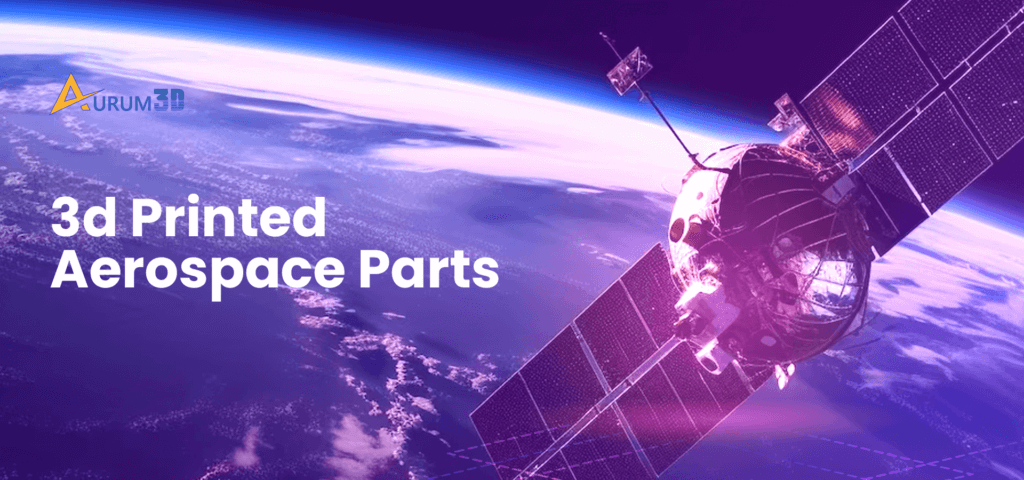3D printing technologies enable engineers to produce parts with complex geometries in a short amount of time. Engineers can use CAD software to create 3D models that represent a new or custom part digitally.
Also, they can convert the digital 3D model into a functional part using multiple 3D printing technologies. Hence, additive manufacturing or 3D printing technologies have already started transforming several industries, including aerospace.
Top aerospace companies leverage plastic, resin, and metal 3D printing technologies to overcome major shortcomings of conventional and subtractive manufacturing techniques. The production of aerospace parts and components is one of the most noticeable 3D printing use cases in the aerospace industry.
At present, aerospace companies use industrial plastic and metal 3D printers to produce large-scale engine components. Also, the Industry 4.0 technology helps them save the time and cost required for producing various fixtures, gauges, jigs, and templates.
There are several reasons why 3D printed aerospace parts have become common in the aerospace industry. We can understand why aerospace companies prefer 3D printing parts and components by discussing some of these important reasons.
10 Reasons Why Aerospace Companies 3D Print Various Parts and Components
Decrease Lead Time
Subtractive manufacturing methods produce large parts faster than 3D printing technologies. However, 3D printing beats subtractive manufacturing in the category of lead time while producing small parts or components in small volumes. Manufacturers opt for 3D-printed aerospace parts to speed up production according to changing and emerging needs.
Reduce Aircraft Weight
The amount of weight consumed and carbon dioxide emitted by an aircraft depends on its weight. One kilogram decrease in an aircraft’s weight makes it emit 25 tons of carbon dioxide less in its lifetime. 3D printing creates opportunities for aerospace companies to experiment with many lightweight materials. Engineers can lighten an aircraft by 3D printing engine components and other parts.
Consolidate Parts and Components
While producing an aircraft, engineers assemble multiple and complex parts. The increase in the number of parts increases manufacturing time and required maintenance. 3D printing helps engineers consolidate multiple parts and components. Engineers can use CAD software to build 3D models that represent the consolidated part digitally. Further, they can use 3D printers to ensure the design and functional accuracy of the solid consolidated part.
Create Complex Geometries
Unlike subtractive manufacturing methods, 3D printing technologies do not support limited shapes. When 3D printing aerospace parts, engineers can experiment with many shapes, patterns, and geometries. They can use CAD software to design parts with complex geometries and sophisticated scale models. They can subsequently convert the digital part into a functional part or prototype using the right 3D printing technology and material.
Facilitate Part Customization
Engineers have to customize aerospace parts and components according to precise project and mission requirements. They cannot produce customized parts in a short amount of time using conventional manufacturing techniques. They can design custom parts using 3D modeling software and use 3D printers to convert the digital model into a solid aerospace part.
Experiment with Many Materials
3D printing machines and materials have been evolving consistently. At present, an aerospace company can produce parts using several plastic, resin, and metal 3D printing technologies. Each type of 3D printing technology supports a wide variety of materials and filaments.
Also, new-age technologies like PolyJet enable engineers to produce parts using multiple materials. The extensive material options create opportunities for aerospace companies to experiment with many lightweight and high-performing materials according to the precise aerospace applications.
Speed up Prototyping
Rapid prototyping is one of the prominent trends across industries. Each aerospace company explores ways to reduce the time required to create, test, and refine new designs. 3D modeling software helps engineers design parts with complex geometries and intricate designs.
Engineers can use 3D printers to produce test iteration models of parts in several hours. Also, they can customize and update the iteration model regularly according to test results. That is why; it becomes easier for aerospace companies to produce 3D-printed parts without investing extra time and resources.
Avoid Tooling Changes
While producing aerospace parts conventionally, engineers have to use multiple tooling and adjust tooling settings. 3D printers produce aerospace parts by depositing material layer by layer without using any tooling. Hence, it becomes easier for aerospace companies to purchase and upgrade expensive tooling regularly.
Become Sustainable
The aerospace industry emits about one billion metric tons of carbon every year. Aerospace companies try to become sustainable by setting emission-reduction targets. 3D printing of parts helps aerospace companies achieve sustainability targets in several ways.
As noted earlier, engineers can make an aircraft consume less fossil fuel by 3D printing lightweight parts. At the same time, aircraft companies can reduce material wastage significantly by switching from subtractive manufacturing to additive manufacturing.
Reduce Production Costs
Aerospace companies leverage 3D printing technologies to produce parts and components without escalating costs. Engineers can use 3D printers to produce the required parts on demand. Hence, aerospace companies are not required to build and maintain infrastructure. At the same time, 3D printing creates opportunities for aerospace companies by reducing material wastage, supply chain cost, and tooling change expenses.
Conclusion
3D printing is one of the Industry 4.0 technologies that have started shaping and transforming the aerospace industry. Aerospace companies have already moved from subtractive manufacturing to additive manufacturing to produce common and complex parts with reduced time and cost.
Many aerospace companies have set up in-house 3D printing facilities to produce parts and prototypes on demand using various 3D printing materials. At the same time, many 3D printing service providers have built a reputation by producing complex and custom parts for aerospace companies.
Investment in R&D will result in the creation of new 3D printing use cases in the aerospace industry regularly. But 3D printed parts and components will remain one of the most significant and visible applications of 3D printing in the aerospace industry.
About Aurum3D
We are amongst the major 3D printing companies in Bangalore, India. We have been providing custom FDM, SLA and SLS 3D Printing services to many major industries including multiple disciplines of engineering. Please feel free to get in touch with us for your custom needs, our 3D printing solutions experts will get back to you within one business day.

